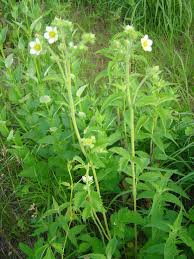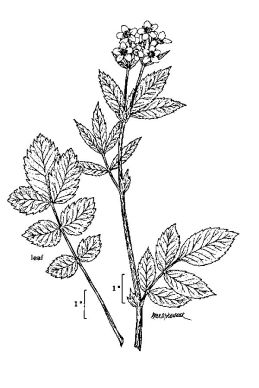

USDA NRCS. Wetland flora: Field office illustrated guide to plant species. USDA Natural Resources Conservation Service.
Where Commonly Found: Roadsides, meadows and open woods, CT (rare in western CT), MA, ME, NH, NY, RI, VT (rare in southern VT) – do not collect where it is rare!
How to Identify:
(For unfamiliar words: Wikipedia Glossary of Botanical Terms).
Go Botany Key for Drymocallis arguta
Wildflower Center‘s description of Drymocallis arguta. Click on more images.
Flower Type: White flower cluster tightly at the top of the plants, sometimes some smaller side clusters. 5 white petals, 5 light green sepals and 20 or more gold stamens with a small golden pistil in the center. Flowers are about 3/4″ across and resemble strawberry flowers.
Flower Time: July – August
Leaf Arrangement: Most of the leaves are gathered at the base of the plants with a few compound leaves alternate along the stout central stem which is covered in white hairs. Overall plant appearance is light or whitish green.
Leaf Type: Pinnate compound leaves with 3 – 11 blunt-tipped, ovate or oblong leaflets, 3″ long and 2″ across, coarsely serrated along the margins and pinnately veined.
Height: 2′-3′
Seed Collection: Pistils that are pollinated will develop into a small head filled many small brown seeds which are enclosed in a cup of dried sepals.
Attracts: Bees, Flies and Beneficial Insects
Use: Naturalizing
Light: Full Sun to Part Sun
Hardiness Zone: 4 to 8 USDA Zone Map
Soils: Well-Drained
Notes: Strong straight stems, dividing near the top with a long season of showy flower clusters. Tall Cinquefoil is prone to some reseeding, so best in a naturalizing garden or meadow. Noted as deer-resistant.
Native to NE, Mid-Atlantic and Midwest. NOTE: RARE IN VT AND CT. Biota of North America Program (BONAP) – North American Plant Atlas (NAPA).
You must be logged in to post a comment.